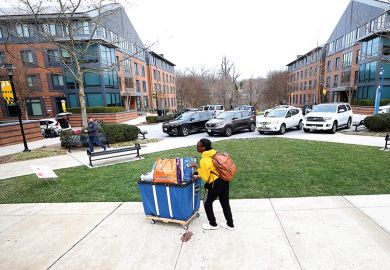I dared to do it again. I called on one of the Zoom windows that only had a name on a black screen. And then I counted slowly to five. Nothing. I repeated the question: “Lauren [not her real name], can you help us? Can you name one of the checks in the American political system?” I held my breath, waiting to see if there was life at the other end of the connection. But there was only silence. Clearly remote teaching has its challenges.
While another student explained how the Senate checks the President’s power to nominate judges to the Supreme Court (at least under normal circumstances), I noticed that Lauren had sent me a comment via Zoom’s chat function. She apologised for not responding to my question and explained that she could not turn on her microphone right now because she was working at the checkout counter in a grocery store.
This wasn’t the first time that I had encountered a student unable to give their full attention to my online classes. Several of my students, I had discovered, had babysat younger siblings, their own children, or other parents’ kids during a number of my classes. They usually kept their cameras and microphones off but when I called on them, they often turned them on – sometimes just in time for me to hear a crying baby in the background or see a talkative toddler grabbing the student.
Another student turned on the camera and introduced me to his manager while making pies in a pizzeria. And yet another replied to my insistent question having apparently just ducked into a cleaning closet at Best Buy.
THE Campus resource: How to deliver online courses with equity at their core
I teach at a small private university in New Jersey, most of whose students are recruited locally and from neighbouring states. Minorities make up a substantial part of the student population and many are first-generation attendees.
In contrast to many other four-year colleges, we have had only minuscule enrolment issues during this fall semester, but, offered the choice of live-taught, hybrid and fully remote courses, most undergraduates chose the latter. I also chose to teach remotely. My classes consisted of videotaped lectures (I recorded about 65 lectures last summer), written (or recorded) student work and synchronous class meetings twice a week for an hour and a half.
My experience was that there seemed to be a clear relationship between socio-economic class – which is highly racialised in the US – and online access and presence. The students on my honours course, for example, were nearly all white – and all had perfect attendance and always kept their cameras on. By contrast, other classes had good attendance but a number of the students (many non-white) left their cameras off. Those who were not at work sometimes emailed me to explain that they were struggling with spotty internet connections. Some were sitting in their cars attending the Zoom class via cell phone; occasionally they emailed me after class to explain that they could not connect at all.
My college benefits from advertising its diversity and recruiting diverse students, yet it does not consider their socio-economic circumstances during the pandemic. Although all students face the same high costs of tuition, the more precarious economic circumstances of some cause them to experience remote classes quite differently – thereby reinforcing the structural inequalities that already exist in society.
Moreover, the financially driven urge to fill classes with so many students – my intro class had more than 30 – makes it difficult for professors to give attention to students who have special circumstances – perhaps through extra office hours or via additional one-on-one Zoom meetings.
THE Campus resource: Strengthening student services online
It is true that inequality of educational experience long predates the pandemic. During normal times, disadvantaged students arrive at lectures tired out after long shifts on the grocery store checkout – if they make it at all. But in conversations with students this past year, I have often heard that the pandemic has made it much harder for minority and first-generation students to stay in college and maintain their good academic standing because of extenuating circumstances; I’ve not heard that from my honours students and other students who seem economically better situated. While these are very subjective impressions, it seems that Covid-19 has put a lot more pressure on families and individuals who are not well off.
These students will do what they can to get through the pandemic without dropping out of college. Picking up extra shifts at the grocery store is one way. But surely there are better ones? Technological and financial support to students in need would alleviate the stress. For instance, reduced tuition payments and scholarships for people with specific, urgent hardship would be very helpful: at my university, a full ride was $45,120 in 2020.
There are no doubt any number of specific solutions that we as educators can collectively dream up. But the first necessary step is for us all, including university administrators, to recognise this as the problem it is.
Barbara Franz is professor of political science at Rider University, New Jersey.
Register to continue
Why register?
- Registration is free and only takes a moment
- Once registered, you can read 3 articles a month
- Sign up for our newsletter
Subscribe
Or subscribe for unlimited access to:
- Unlimited access to news, views, insights & reviews
- Digital editions
- Digital access to THE’s university and college rankings analysis
Already registered or a current subscriber?








